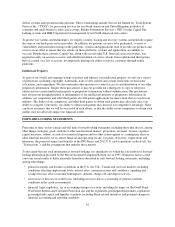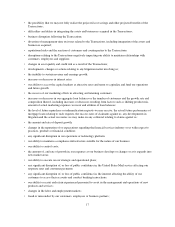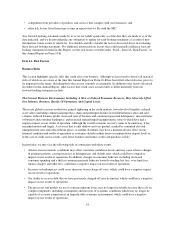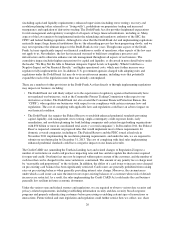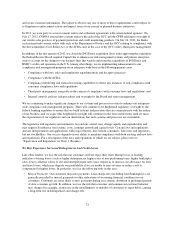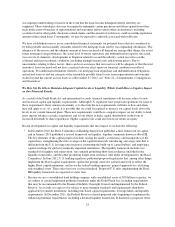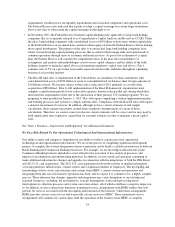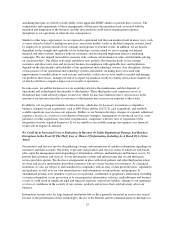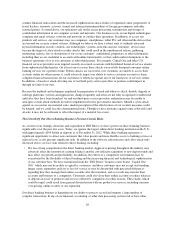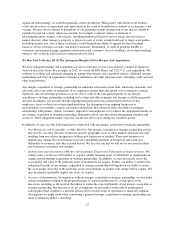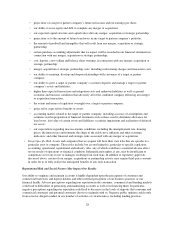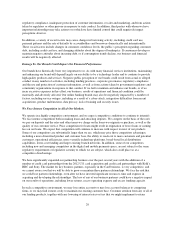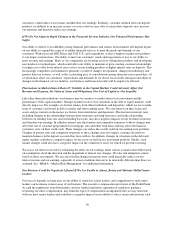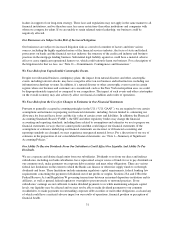Capital One 2012 Annual Report Download - page 41
Download and view the complete annual report
Please find page 41 of the 2012 Capital One annual report below. You can navigate through the pages in the report by either clicking on the pages listed below, or by using the keyword search tool below to find specific information within the annual report.•Estimates of Inherent Losses. The credit quality of our portfolio can have a significant impact on our
earnings. We allow for and reserve against credit risks based on our assessment of credit losses inherent in
our loan portfolios. This process, which is critical to our financial results and condition, requires complex
judgments, including forecasts of economic conditions. We may underestimate our inherent losses and fail
to hold a loan loss allowance sufficient to account for these losses. Incorrect assumptions could lead to
material underestimates of inherent losses and inadequate allowance for loan and lease losses. In addition,
our estimate of inherent losses impacts the amount of allowances we build to account for those losses. In
cases where we modify a loan, if the modifications do not perform as anticipated we may be required to
build additional allowance on these loans. The increase or release of allowances impacts our current
financial results.
•Underwriting. Our ability to assess the credit worthiness of our customers may diminish.If the models and
approaches we use to select, manage and underwrite our consumer and commercial customers become less
predictive of future charge-offs (due, for example, to rapid changes in the economy, including the
unemployment rate), our credit losses may increase and our returns may deteriorate.
•Business Mix. Our business mix could change in ways that could adversely affect credit losses.We engage
in a diverse mix of businesses with a broad range of credit loss characteristics.Consequently, changes in our
business mix may change our charge-off rate.
•Charge-off Recognition. The rules governing charge-off recognition could change.We record charge-offs
according to accounting and regulatory guidelines and rules.These guidelines and rules, including FASB
standards and the FFIEC Account Management Guidance, could require changes in our account
management or loss allowance practices and cause our charge-offs and/or allowance for loan and lease
losses to increase for reasons unrelated to the underlying performance of our portfolio.Such changes could
have an adverse impact on our financial condition or results of operation.
•Industry Developments. Our charge-off and delinquency rates may be negatively impacted by industry
developments, including new regulations applicable to our industry.
•Collateral. Collateral, when we have it, could be insufficient to compensate us for loan losses.When
customers default on their loans and we have collateral, we attempt to seize it where permissible and
appropriate.However, the value of the collateral may not be sufficient to compensate us for the amount of
the unpaid loan, and we may be unsuccessful in recovering the remaining balance from our customers.
Particularly with respect to our commercial lending and home loan activities, decreases in real estate values
adversely affect the value of property used as collateral for our loans and investments.Thus, the recovery of
such property could be insufficient to compensate us for the value of these loans. Borrowers may be less
likely to continue making payments on loans if the value of the property used as collateral for the loan is
less than what the borrower owes, even if the borrower is still financially able to make the payments.
•New York Concentration. Although our lending is geographically diversified, approximately 37% of our
commercial loan portfolio is concentrated in the New York metropolitan area. The regional economic
conditions in the New York area affect the demand for our commercial products and services as well as the
ability of our customers to repay their commercial loans and the value of the collateral securing these loans.
An economic downturn or prolonged period of slow economic growth in, or a catastrophic event that
disproportionately affects, the New York region could have a material adverse effect on the performance of
our commercial loan portfolio and our results of operations.
We May Experience Increased Losses Associated With Mortgage Repurchases and Indemnification
Obligations.
Certain of our subsidiaries, including GreenPoint Mortgage Funding, Inc. (“GreenPoint”), Capital One Home Loans
and Capital One, N.A., as successor to Chevy Chase Bank, may be required to repurchase mortgage loans that have
been sold to investors in the event there are breaches of certain representations and warranties contained within the
sales agreements. We may be required to repurchase mortgage loans that we sell to investors in the event that there
22






